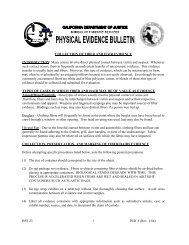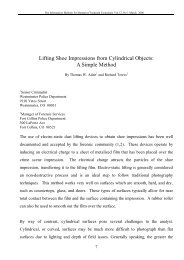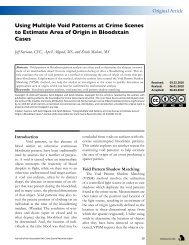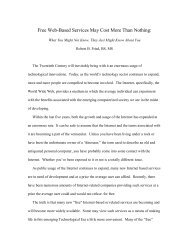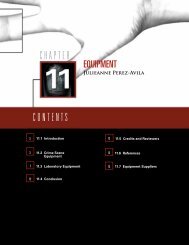PHYSICAL EVIDENCE MANUAL - Crime Scene Investigator Network
PHYSICAL EVIDENCE MANUAL - Crime Scene Investigator Network
PHYSICAL EVIDENCE MANUAL - Crime Scene Investigator Network
Create successful ePaper yourself
Turn your PDF publications into a flip-book with our unique Google optimized e-Paper software.
Physical Evidence Manual<br />
Field Test Kits<br />
When using commercially purchased field test kits, remember a positive result<br />
with the kit only indicates the possible presence of a drug. There can be other<br />
substances that give the same reaction. Generally, the colors of a positive<br />
reaction indicated on the test kit are very apparent and interpretation of the result<br />
is usually not necessary.<br />
The field test kits should be discarded after use. Many of the kits contain<br />
concentrated acids that can leak, creating a chemical hazard. In addition, drugs<br />
tested in these kits cannot be further analyzed and therefore should not be<br />
submitted to the laboratory.<br />
Officers using field test kits should not do so on a residue amount of drug. In<br />
cases where quantities are limited, omit the field test and submit the evidence<br />
directly to the laboratory for analysis.<br />
Clandestine Drug Laboratories<br />
Clandestine drug laboratories range from crude makeshift operations to<br />
sophisticated and technologically complex facilities. They can be set up<br />
anywhere and are often found in private residences, hotel and motel rooms,<br />
trailers, barns and outbuildings, and commercial buildings. At these locations<br />
sophisticated surveillance equipment and booby-traps may be set up to deter<br />
intruders and law enforcement personnel from entering.<br />
Extreme care and caution should be exercised whenever investigating or<br />
processing a clandestine drug lab site. The chemicals and substances used in<br />
the manufacturing process can be caustic, explosive, carcinogenic, poisonous,<br />
irritating, and flammable. Laboratory and law enforcement personnel participating<br />
in clandestine drug laboratory investigations should have specialized training in<br />
the use of protective equipment and the appropriate health and safety<br />
procedures.<br />
The processing of clandestine drug laboratories also involves the sampling,<br />
removal, and proper disposal of hazardous toxic chemicals. The transportation<br />
and disposal of these chemicals is regulated by state and federal environmental<br />
protection agencies.<br />
There are usually two situations when a clandestine laboratory is encountered.<br />
The first is when police or fire agency personnel encounter a previously unknown<br />
lab. When this occurs the personnel should secure the scene, allow no<br />
unauthorized or unnecessary entry, and contact the local specialized unit or<br />
trained personnel to process clandestine laboratories.<br />
Adopted: May 2002<br />
Revisions: 6<br />
Last Revision: January 31, 2008<br />
7-3



